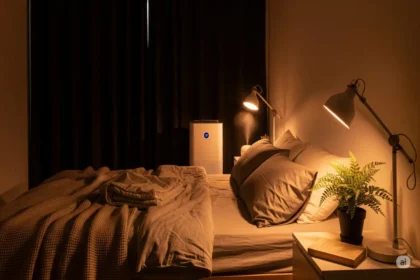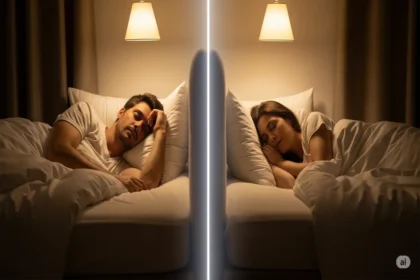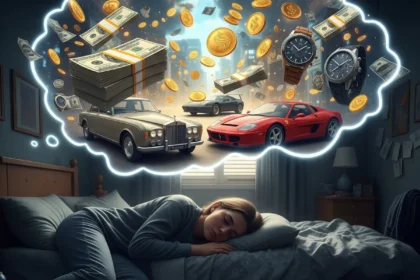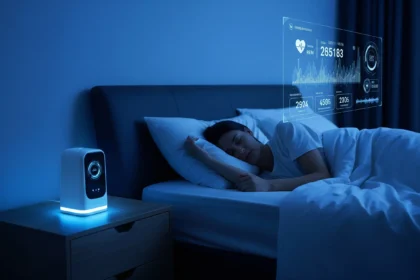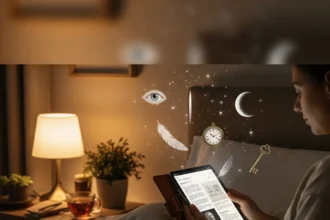The line between waking and sleeping often feels absolute, a clear boundary between the conscious world we navigate daily and the mysterious realm of our dreams. But what if that line could blur, just enough for you to step across it, fully aware, into your own nocturnal narrative? Imagine flying through canyons, conversing with figments of your imagination, or even practicing new skills – all while deeply asleep. This captivating phenomenon is known as lucid dreaming, and for many, the idea of a comprehensive guide to lucid dreaming feels like unlocking a secret superpower.
My first encounter with the concept was purely accidental. I was a teenager, grappling with recurring nightmares that left me rattled each morning. One night, amidst the familiar terror of being chased through an endless, labyrinthine house, a sudden, almost electric jolt of realization hit me: This isn’t real. I’m dreaming. The house dissolved, the fear evaporated, and I found myself, albeit briefly, floating above a cityscape that was entirely my own creation. It was fleeting, exhilarating, and left me with a profound sense of awe. That spark ignited a lifelong fascination with the mechanics of sleep and consciousness, pushing me to explore the science and the art of this extraordinary state.
What Exactly is Lucid Dreaming? The Science of Conscious Sleep
At its core, lucid dreaming is simply being aware that you are dreaming while the dream is happening. This awareness can range from a fleeting recognition to a profound sense of self-presence and control within the dream environment. It’s not about waking up; it’s about waking up within the dream.
Neuroscience tells us that lucid dreams primarily occur during the Rapid Eye Movement (REM) stage of sleep. This is the stage characterized by intense brain activity, similar to wakefulness, yet accompanied by muscle paralysis (atonia) to prevent us from acting out our dreams. During a lucid dream, specific areas of the brain, particularly the prefrontal cortex (associated with higher-order cognitive functions like self-awareness, decision-making, and planning), show heightened activity. It’s as if a part of our waking consciousness “switches on” while the rest of the brain continues its dreaming processes.
Dr. Stephen LaBerge, a leading psychophysiologist and pioneer in lucid dream research at Stanford University, has conducted groundbreaking studies using objective physiological markers, like volitional eye movements (where a lucid dreamer signals their awareness through pre-agreed eye movements), to confirm the reality of lucid dreaming. His work has shifted lucid dreaming from the realm of anecdotal curiosity to a legitimate field of scientific inquiry. It’s a remarkable intersection of psychology, neuroscience, and personal exploration.
For someone like Alex, a graphic designer I spoke with, lucid dreaming became a powerful tool for overcoming creative blocks. “I’d get stuck on a logo design, completely out of ideas,” he explained. “Then I started intentionally trying to lucid dream. In one dream, I asked the ‘dream me’ to show me a solution. The next thing I knew, I was sketching a concept that was completely fresh and unexpected. It was like tapping into a different part of my brain.” Alex’s experience underscores the potential of lucid dreaming beyond mere entertainment, hinting at its capacity for problem-solving and self-discovery.
Preparing the Canvas: Essential Foundations for Lucid Dreaming
Before attempting specific techniques, laying a solid foundation is crucial. Think of it as preparing the ground before planting seeds.
1. Dream Recall: Your Memory Blueprint
You can’t become lucid in a dream if you can’t remember your dreams at all. This is the absolute first step.
- Dream Journaling: Keep a dream journal by your bedside. As soon as you wake up, before even getting out of bed, record everything you remember – even fragments. Write down images, feelings, sounds, and narratives. Don’t censor yourself. The act of recalling and writing helps train your brain to pay more attention to your dreams, improving recall over time. Consistent journaling (even if you only recall bits at first) is paramount. The more you practice, the more vivid and detailed your dream memories will become, providing fertile ground for lucidity.
2. Sleep Hygiene: The Optimal Environment
Lucid dreams occur during REM sleep, and consistent, good quality REM sleep is vital. Without sufficient, undisturbed REM, your chances of lucidity diminish significantly.
- Regular Sleep Schedule: Go to bed and wake up at roughly the same time every day, even on weekends. This stabilizes your circadian rhythm and maximizes your REM sleep periods, which become longer and more frequent in the latter half of the night.
- Comfortable Sleep Environment: Ensure your bedroom is dark, quiet, and cool. Avoid screens (phones, tablets, TV) at least an hour before bed, as blue light can suppress melatonin and disrupt REM sleep. Create a sanctuary that signals to your brain it’s time to rest deeply.
- Avoid Sleep Disruptors: Limit caffeine and alcohol, especially in the hours before bed. Both can fragment sleep and reduce REM. While alcohol might make you feel drowsy initially, it leads to fragmented sleep later, robbing you of crucial REM time.
The Pathways to Awareness: Beginner-Friendly Lucid Dreaming Techniques
Once you have a consistent dream recall practice and good sleep hygiene, you can begin experimenting with specific techniques designed to trigger lucidity. Consistency and patience are key; it rarely happens on the first try.
1. Reality Testing (RT): The Everyday Query
This is perhaps the most widely recommended and effective beginner technique. The idea is to perform a simple “test” multiple times throughout your waking day to determine if you are dreaming or awake. If you make this a habit in waking life, you’ll eventually perform it in a dream, and when it yields a “dream result,” you’ll become lucid.
- How to do it:
- Nose Pinch Test: Pinch your nose and try to breathe through it. In a dream, you’ll likely still be able to breathe. In waking life, you won’t. This is a classic and highly reliable test.
- Hand Gaze Test: Look at your hands. Are they normal? Do they have the right number of fingers? Then look away and look back. Do they change? In dreams, hands often appear distorted, shift, or change form, providing a clear indication that you’re dreaming.
- Text/Time Test: Look at a digital clock or a piece of text, look away, and then look back. In dreams, text often changes, becomes gibberish, or the time shifts wildly. This highlights the fluidity of dream logic.
- Jump Test: Try to gently push off the ground and see if you float or jump unnaturally high. This taps into the altered physics of the dream world.
- When to do it: Don’t just do it randomly. Associate reality testing with “dream signs” you identify in your journal (e.g., if you often dream of a certain person or place, do an RT every time you encounter them in waking life). Also, perform RTs during moments of unusualness, confusion, or strong emotion in your waking day, as these states often mirror dream characteristics. The more you question your reality during the day, the more likely you are to question it in a dream.
2. Mnemonic Induction of Lucid Dreams (MILD): The Intention Setter
Developed by Dr. Stephen LaBerge, MILD is one of the most scientifically validated techniques. It focuses on setting an intention to become lucid before you fall asleep.
- How to do it:
- Set your alarm for 4-6 hours after you fall asleep (this is typically when REM periods are longer and more vivid dreams occur).
- When the alarm goes off, stay awake for 20-30 minutes. Get out of bed, read your dream journal, or do something quiet and non-stimulating. This brief period of wakefulness helps to increase your alertness before re-entering REM.
- Lie back down. As you do, tell yourself, “Next time I’m dreaming, I will remember that I’m dreaming.” Repeat this phrase several times, vividly imagining yourself becoming lucid in a dream.
- Visualize a recent dream you had (or a common dream theme from your journal). As you visualize it, imagine becoming lucid within that dream, perhaps by performing a reality test within the dream scenario.
- Continue this visualization and intention-setting until you fall back asleep. The power of MILD lies in its combination of conscious intention and targeted visualization.
3. Wake Back to Bed (WBTB): The REM Amplifier
Often used in conjunction with MILD, WBTB maximizes your chances of entering a dream directly from a period of wakefulness, increasing the likelihood of lucidity.
- How to do it:
- Similar to MILD, set an alarm for 4-6 hours after falling asleep.
- Stay awake for 30-60 minutes this time. Engage in a mentally stimulating but not overly exciting activity related to lucid dreaming (e.g., reading about lucid dreaming, watching a video on the topic, or contemplating your intentions for lucidity). Avoid bright screens or anything that might fully wake you up.
- Go back to sleep, preferably incorporating the MILD technique. The extended wakefulness boosts your alertness, and returning to sleep often plunges you directly into REM, increasing your chances of becoming lucid. This technique is particularly effective because it primes your mind for lucidity right before a prime dreaming window.
4. Dream Sign Recognition: The Personal Clues
As you diligently keep a dream journal, you’ll start noticing recurring themes, objects, or bizarre occurrences. These are your personal “dream signs.”
- How to use it: Pay attention to common dream phenomena: flying, falling, interacting with deceased loved ones, technological devices not working, impossible architecture, sudden changes in location, or characters you know acting out of character. When you notice these patterns, train yourself to perform a reality test every time they appear in your dreams. The goal is to recognize them while dreaming and trigger lucidity. For example, if you frequently dream of losing your teeth, resolve that the next time you feel your teeth falling out, you will recognize it as a dream sign and perform a reality test. This technique leverages your unique dream landscape to your advantage.
What to Do When You’re Lucid: Exploring Your Dream World
Once you achieve lucidity, the possibilities are vast. However, initial lucidity can be fragile, and the excitement can sometimes cause you to wake up. Here’s how to stabilize and explore:
- Stabilize: When you first become lucid, the dream might feel unstable or you might feel yourself waking up. Spin around slowly in the dream, rub your hands together, or touch objects in the dream. These actions help to ground you and increase sensory input, making the dream more vivid and stable. Repeating “I am dreaming” can also help reinforce your awareness.
- Explore: Start small. Don’t try to fly immediately if you’ve just become lucid. Try changing the color of an object, walking through a wall, or summoning a familiar object. Gradually increase the complexity of your actions as your control and stability improve. The dream world is your personal sandbox; experiment with its rules.
- Interact: Talk to dream characters. Ask them questions – you might be surprised by the answers, which often come from your own subconscious. These interactions can be incredibly insightful, revealing hidden aspects of your mind.
- Purposeful Dreaming: Beyond mere entertainment, lucid dreaming can be used for:
- Problem Solving: As Alex did, present a problem to your dream self. Your subconscious might offer unexpected solutions.
- Skill Rehearsal: Practice public speaking, a musical instrument, or a sport. Research suggests that mental rehearsal in a lucid dream can improve real-world performance by strengthening neural pathways.
- Overcoming Fears: Confront phobias or anxieties in a safe, controlled environment. Facing a fear in a dream can help desensitize you to it in waking life.
- Creativity: Explore new ideas, write stories, compose music, or design art. The uninhibited nature of the dream state can be a powerful wellspring of inspiration.
- Self-Exploration: Delve into your subconscious, understand recurring themes in your life, or communicate with different aspects of your psyche. It’s a unique form of introspection.
The Journey of Conscious Dreaming: Patience and Persistence
Learning to lucid dream is not an overnight endeavor. It requires consistent effort, a genuine curiosity about your inner world, and a healthy dose of patience. Many beginners experience periods of rapid progress followed by plateaus. Don’t get discouraged by setbacks or nights without lucidity. Every attempt, every recorded dream, contributes to building the neural pathways necessary for this remarkable skill.
Embrace the process as a fascinating journey of self-discovery. As you unlock your dream world, you’re not just gaining control over your nighttime narratives; you’re gaining deeper insights into your own mind, tapping into reserves of creativity, and perhaps, even redefining the boundaries of your consciousness. So, set your intentions, prepare your journal, and get ready to step into the most extraordinary reality of all – your own. The dream world awaits, ready to be explored by a conscious mind.
Disclaimer: The information provided in this article is for general informational purposes only and does not constitute medical advice. It is not a substitute for professional medical advice, diagnosis, or treatment. Always seek the advice of your physician or other qualified health provider with any questions you may have regarding a medical condition. Never disregard professional medical advice or delay in seeking it because of something you have read on this website.



